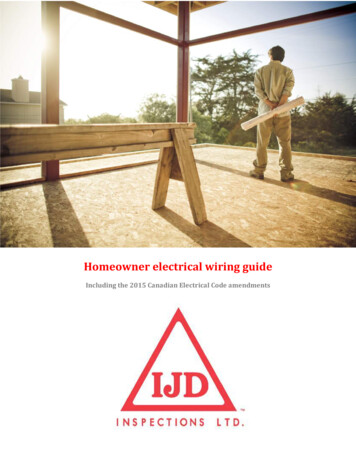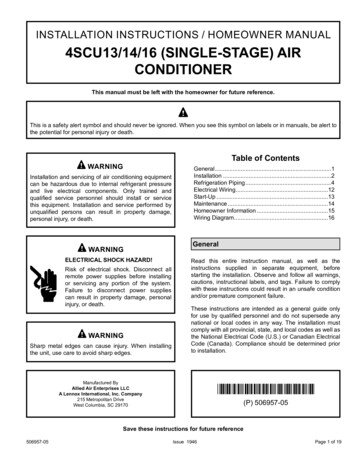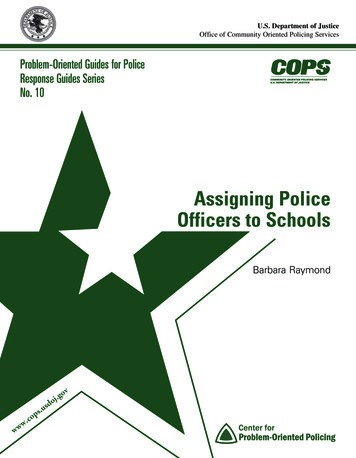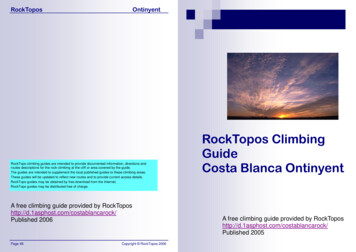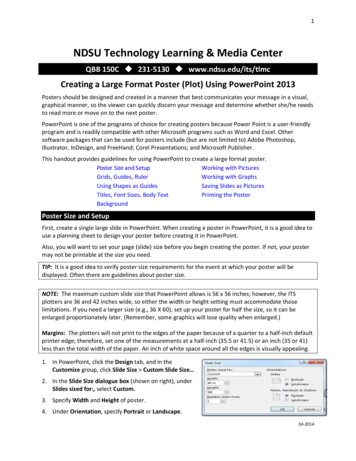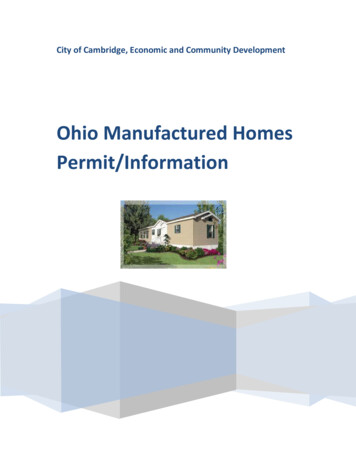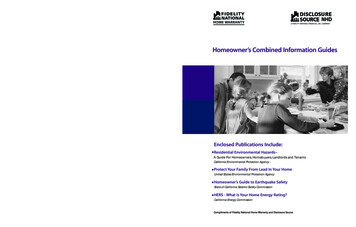
Transcription
Homeowner’s Combined Information GuidesTel: 1-800-TOCOVER (800-862-6837)Fax: 1-800-308-1460www.homewarranty.comTel: 1-800-880-9123Fax: 1-800-287-8673www.disclosuresource.comEnclosed Publications Include:Residential Environmental Hazards A Guide For Homeowners, Homebuyers, Landlords and TenantsCalifornia Environmental Protection Agency -Protect Your Family From Lead In Your HomeUnited States Environmental Protection AgencyHomeowner’s Guide to Earthquake SafetyState of California Seismic Safety CommissionHERS - What is Your Home Energy Rating?California Energy CommissionCompliments of Fidelity National Home Warranty and Disclosure Source
CALIFORNIA ENVIRONMENTALPROTECTION AGENCYRESIDENTIAL ENVIRONMENTALHAZARDS:A Guide For Homeowners, Homebuyers,Landlords and Tenants2011This guide was originally developed by M. B. Gilbert Associates, under contract with theCalifornia Department of Real Estate in cooperation with the California Department ofHealth Services. The 2005 edition was prepared by the California Department of ToxicSubstances Control, in cooperation with the California Air Resources Board and theCalifornia Department of Health Services, and meets all State and Federal guidelinesand lead disclosure requirements pursuant to the Residential Lead-Based Paint HazardReduction Act of 1992. The 2005 edition incorporates the Federal “Protect Your Familyfrom Lead” pamphlet. The 2011 update was developed California Department of ToxicSubstances Control. This booklet is offered for information purposes only, not as areflection of the position of the administration of the State of California.Residential Environmental Hazards BookletPage 1 of 48January 2011
Table of ContentsINTRODUCTION3CHAPTER I ASBESTOS3CHAPTER II CARBON MONOXIDE10CHAPTER III FORMALDEHYDE13CHAPTER IV HAZARDOUS WASTE17CHAPTER V HOUSEHOLD HAZARDOUS WASTE21CHAPTER VI LEAD24CHAPTER VII MOLD31CHAPTER VIII RADON36APPENDIX A LIST OF FEDERAL AND STATE AGENCIES42APPENDIX B GLOSSARY46Residential Environmental Hazards BookletPage 2 of 48January 2011
IntroductionThe California Departments of Real Estate and Health Services originally prepared thisbooklet in response to the California legislative mandate (Chapter 969, Statutes of1989, AB 983, Bane) to inform the homeowner and prospective homeowner aboutenvironmental hazards located on and affecting residential property.The 2005 edition was prepared by the California Department of Toxic SubstancesControl, in cooperation with the California Air Resources Board and the CaliforniaDepartment of Health Services’ Childhood Lead PoisoningPrevention Program, Radon Program, and Division of Drinking Water andEnvironmental Management, in response to a 1994 legislative mandate (Chapter 264,Statutes of 1994, AB 2753, Sher). The 1994 legislation also requires this booklet toconsolidate the California disclosure requirements (Ch. 969, Statutes of 1989) and thefederal disclosure requirements (The Residential Lead-Based Paint Hazard ReductionAct of 1992).The information contained in this booklet is an overview of some environmental hazardswhich may be found on or in residential property and which may affect residential realestate. Since this booklet is not meant to be all inclusive, it should be used only forgeneral guidance. Although law requires the disclosure of known hazards, anenvironmental survey may be conducted to obtain further information. Homeowners,tenants, and prospective homeowners may wish to obtain other literature for additionalinformation on hazards of concern.In California, sellers are required to disclose the presence of any known environmentalhazard. A statement that the homeowner is unaware of environmental hazards is not aguarantee that the property is free of such hazards. It is in the homeowner’s andprospective homeowner’s interest to know what hazards are common, where they arefound, and how they might be mitigated. This booklet will provide homeowners andprospective homeowners with the information and additional resources needed to makean informed decision about environmental hazards that may be present on a property.Because of the contribution of household hazardous wastes to the problem ofhazardous waste disposal, a section on proper storage and disposal of householdhazardous products is included. In discussing health impacts of hazardous substances,lifetime exposure to low levels is emphasized because the resident is more likely toencounter this type of exposure than exposure to high levels of hazards for a short time.Sources of additional information and a list of government agencies are provided forfurther information.Pursuant to AB 983, if this environmental hazards booklet is made available tohomeowners or prospective homeowners, real estate licensees and home sellers arenot required to provide additional information on such hazards. However, delivery of thispublication to homeowners or prospective homeowners does not relieve home sellersResidential Environmental Hazards BookletPage 3 of 48January 2011
and real estate licensees of the responsibility to disclose the existence of environmentalhazards when such hazards are known to them.The material is presented with the understanding that the publisher is not engaged inoffering legal or other professional advice. If legal or other expert assistance is required,the services of a skilled professional should be obtained.Residential Environmental Hazards BookletPage 4 of 48January 2011
CHAPTER I ASBESTOSWhat is Asbestos?Asbestos is the name given to a number of naturally occurring fibrous silicate mineralsthat have been mined for their useful properties such as thermal insulation, chemicaland thermal stability, and high tensile strength. The three common types of asbestosare chrysotile, amosite, and crocidolite. Chrysotile, also known as white asbestos and amember of the serpentine mineral group, is the most common. Asbestos can only beidentified under a microscope.Where is asbestos found in the home?Asbestos has been used in many products found in the home that provide insulation,strength, and fire protection. In 1989, the U.S. Environmental Protection Agency (U.S.EPA) announced a phased ban of asbestos products to be completed by 1996.However, in 1991, the U.S. Fifth Circuit Court of Appeals overturned and remanded theasbestos ban and phase-out rule to EPA. Today, most asbestos products can still belegally manufactured, although production of asbestos containing materials hasdecreased dramatically since the late 1970s. The most common items in the home thatmay contain asbestos are: Vinyl flooringDuct wrapping on heating and air conditioning systemsInsulation on hot water pipes and boilersSome roofing shingles, and sidingVermiculite attic insulationCeiling and wall insulationSheet rock taping compounds and some ceiling materialsAsbestos that has been sprayed on ceilings often has a spongy, “cottage cheese”appearance with irregular soft surfaces. Asbestos troweled on walls has a textured, firmappearance. Vermiculite attic insulation, found both in the attic between trusses and inbetween walls, also has the potential to contain asbestos. Vermiculite attic insulation isa pebble-like, pour-in product and is usually light-brown or gold in color.Manufacturers can provide information on the asbestos content of home products. Acertified asbestos consultant can be hired to test building material and determinewhether or not asbestos is present and to give advice about how to take care of itsafely. Current asbestos bulk testing methods may be insufficient to determine thepresence of asbestos in vermiculite attic insulation. For more information on vermiculite,see U.S. EPA’s Protect Your Family from Asbestos-Contaminated Vermiculite atwww.epa.gov/asbestos/pubs/verm questions.html.Residential Environmental Hazards BookletPage 5 of 48January 2011
How is asbestos harmful?Intact or sealed (painted or taped over) asbestos is not harmful unless it becomesdamaged and friable. Friable means the material can be easily crushed or pulverized toa powder by hand pressure. Friable materials have a higher potential to release fibers.Asbestos fibers that are released into the air and inhaled can accumulate in the lungsand pose a health risk. This risk can be divided into two general categories: risk ofasbestosis (lung scarring); and increased risk of cancer.The U.S. EPA classifies asbestos as a known human carcinogen. If asbestos fibers areinhaled, the chance of contracting lung cancer or mesothelioma (cancer of the lining ofthe chest or abdomen) increases. The more asbestos is inhaled, the greater risk ofdeveloping cancer. Smokers who are exposed to high levels of asbestos have a muchgreater risk of developing lung cancer than nonsmokers exposed to the same level.Symptoms of cancer may not develop until 10-40 years after the first exposure toasbestos.Is there a safe level of asbestos?There is no safe level of asbestos exposure. The more asbestos fibers you inhale, thegreater your risk of developing lung cancer and asbestos-related disease. Exposure toasbestos should always be avoided.How can asbestos content in materials be determined?When you suspect asbestos is present in building materials, it is important to have thematerials tested by a qualified laboratory. Visual inspection alone is not enough toidentify the presence of asbestos. It is recommended that you contact a certifiedasbestos consultant to take samples of potential asbestos containing materials andhave them tested by a qualified laboratory. A list of asbestos consultants who havebeen certified by the California Department of Industrial Relations, Division ofOccupational Safety and Health (Cal/OSHA) for evaluating building materials andrecommending a course of action may be obtained on the Internet atwww.dir.ca.gov/Databases/doshacru/acruList.asp or by calling 510-286-7362 .How should the homeowner repair or remove asbestos?Repair or removal of asbestos by the homeowner may be unwise if the damage issevere, since it may result in unnecessary exposure to airborne fibers. In cases whereplanned remodeling projects are expected to damage asbestos-containing materials, itis wise to hire a qualified contractor to remove the material. The homeowner should usethe following guidelines in choosing a qualified contractor: Check to see if the contractor is licensed by the California Contractors StateLicense Board and registered with the California Department of IndustrialResidential Environmental Hazards BookletPage 6 of 48January 2011
Relations, Division of Occupational Safety and Health (Cal/OSHA) for doingasbestos work.Be aware that some contractors may remove material incorrectly and still chargea substantial fee.Require references from the contractor and check them to see if the contractor'swork is satisfactory.Require the contractor to specify his safety procedures in writing.The homeowner can expect to pay three times as much for a small removal job than alarge one as it is expensive for a contractor to set up all the necessary safetyequipment. You should consider hiring a certified asbestos consultant to review safetyprocedures and oversee the performance of the contractor.Does the law require asbestos mitigation?Asbestos mitigation is at the discretion of the homeowner. Even if material containsasbestos, the homeowner may choose to leave it alone or, if necessary, repair it. If thehome owner chooses to do his or her own repairs, the home owner must comply withthe law. The free Department of Toxic Substances Control fact sheet “ManagingAsbestos Waste” is available on the DTSC Web site atwww.dtsc.ca.gov/PublicationsForms/upload/OAD FS Asbestos1.pdfWhat about naturally occurring asbestos that is found near the home?Naturally Occurring Asbestos (NOA) includes six regulated naturally occurring minerals(actinolite, amosite, anthophyllite, chrysotile, crocidolite, and tremolite) and is commonlyfound in California within serpentine and other ultramafic rocks and soils of the CoastalRanges, Klamath Mountains, and the Sierra Nevada Mountains. The CaliforniaGeological Survey has produced a map that identifies areas more likely to contain NOAin California. The map may be found online atwww.consrv.ca.gov/cgs/minerals/hazardous minerals/asbestos/index.htm.Asbestos fibers may be released into the air as a result of activities which disturb NOAcontaining rock or soils. Development construction activities in areas that contain NOAmay release asbestos. Also, driving on roads or driveways surfaced with asbestoscontaining gravel, such as serpentine, may release asbestos. The California AirResources Board (ARB) has established Asbestos Airborne Toxic Control Measures(ATCMs) to regulate the surfacing of roads with asbestos-containing gravels andconstruction and grading activities in areas potentially containing asbestos. For moreinformation about naturally occurring asbestos, go ines:Residential Environmental Hazards BookletPage 7 of 48January 2011
For information on the identification and abatement of asbestos hazards in the home,and other information about asbestos visit the U.S. EPA Asbestos Web site atwww.epa.gov/asbestos .For technical assistance and information about: Toxic Substances Control Act (TSCA);Regulations and programs administered under TSCA, includingasbestos, lead-based paint, and PCB’s; andEPA’s 33/60 voluntary pollution prevention program;Contact the Toxic Substances Control Act Assistance Information Service (T.A.I.S.),Washington, D.C. at:Telephone: (202) 554-1404Fax: (202) 554-560E-mail: tsca-hotline@epa.govPublications:Indoor Air Quality Infosheet - AsbestosThis free publication is available from:American Lung AssociationEnvironmental Health Department909 12th StreetSacramento, CA 95814Telephone: (800) LUNG-USA [(800) 586-4872]The Inside Story - A Guide to Indoor Air QualityAsbestos in Your HomeThese free publications are available from:U.S. EPA Indoor Air Quality Information ClearinghouseP.O. Box 37133Washington, D.C. 20013-7133Telephone: (800) 438-4318FAX: (202) 484-1510E-mail: iaqinfo@aol.comWeb: www.epa.gov/iaqAsbestos in the Home and WorkplaceThis list is available on the Internet from:California Department of Health ServicesIndoor Air Quality ProgramResidential Environmental Hazards BookletPage 8 of 48January 2011
http://www.cdph.ca.gov/programs/IAQ/Documents/IAQ Asbestos 2000-03.pdfList of Certified Asbestos ConsultantsThis list is available on the Internet or by mail for 8.00 from:California Department of Industrial RelationsDivision of Occupational Safety and Health (Cal/OSHA)Asbestos Consultant Certification Unit2211 Park Towne Circle, Suite 1Sacramento, CA 95825Telephone: (916) 574-2993Web: www.dir.ca.govList of Asbestos Abatement ContractorsThis list is available for 25.00 from:California Department of Industrial RelationsDivision of Occupational Safety and Health (Cal/OSHA)Asbestos Contractor Registration Unit455 Golden Gate Avenue, 10th FloorSan Francisco, CA 94102Telephone: (415) 703-5190Web: www.dir.ca.govWhat You Should Know Before You Hire a ContractorThis free publication is available from:California Contractors State License Board9835 Goethe RoadP.O. Box 26000Sacramento, CA 95827Telephone: (800) 321-2752 (To receive the publication, leave your name and addresson message phone.)Note: Telephone numbers and prices were correct at the date of publication of thisbooklet, but are subject to change.Residential Environmental Hazards BookletPage 9 of 48January 2011
CHAPTER II CARBON MONOXIDEWhat is carbon monoxide?Carbon Monoxide (CO) is an odorless, colorless and tasteless gas. It is highly toxic tohumans and animals in higher quantities.Because it is impossible to see, taste or smell, breathing CO can incapacitate or kill youbefore you are aware it is present in your home. At lower concentrations, CO mayproduce flu-like symptoms, including headache, dizziness, disorientation, nausea andfatigue.What are the sources of carbon monoxide in the home?CO is the result of incomplete combustion of carbon fuels and is produced from bothman-made and natural sources. Typical sources of CO in the home are: Unvented kerosene and gas space heatersGas water heatersImproperly adjusted or maintained furnaces or boilersWood stoves and fireplacesGas stoves and ovensGasoline powered equipment, such as generatorsAutomobile exhaustTobacco smokeHow is carbon monoxide harmful?Following inhalation, CO combines with hemoglobin in the blood producingcarboxyhemoglobin, which is ineffective in delivering oxygen to the body tissues.Carbon monoxide binds to other molecules such as myoglobin and mitochondrialcytochrome oxidase and may cause significant damage to the heart and central nervoussystem.At low concentrations, CO exposure may result in fatigue in healthy individuals andchest pain in people with heart disease. At higher concentrations, CO may result inheadache, nausea, dizziness, confusion, impaired vision, angina and reduced brainfunction, depending upon the concentration in air and length of exposure. Exposure tovery high concentrations of CO can be fatal.Breathing high levels of CO during pregnancy may result in miscarriage. Breathingmoderate levels of CO during pregnancy can result in slower than normal mentaldevelopment of your child. In animal studies, exposure to CO during pregnancy hadResidential Environmental Hazards BookletPage 10 of 48January 2011
effects on birth weight, the heart, the central nervous system and development. Childrenwith asthma may be more susceptible to respiratory effects following exposure to CO.What levels of carbon monoxide are found in the home?Typical levels in homes with no gas appliances range from 0.5 to 5 parts per million(ppm). Levels measured near properly adjusted gas appliances were between 5 and 15ppm, while levels near poorly adjusted appliances can be 30 ppm or higher.Is there a safe level of carbon monoxide?No standards for CO have been adopted for indoor air. The National Ambient Air QualityStandards for outdoor air are 9 ppm for eight hours and 35 ppm for one hour. The Stateof California Air Resources Board (ARB) air quality standards for CO are 9 ppm for eighthours and 20 ppm for one hour. The State of California, Office of Environmental HealthHazard Assessment (OEHHA) established an acute, one hour exposure level of 23,000micrograms per cubic meter of air (µg/m3) or 20 ppm for CO. This exposure level wasbased on heart toxicity.Can carbon monoxide be detected and measured?California Senate Bill 183 (SB 183) will require owners of single family homes that havea fossil-fuel burning appliance, fireplace or attached garage to install a CO alarm(s) byJuly 1, 2011. CO detectors trigger an alarm based on accumulation of CO over time orcontinuous detection of CO.What can be done to reduce exposure to carbon monoxide?Always make sure that gas appliances are maintained and properly installed. Here aresome common tips to reduce potential CO levels in your home: Make sure appliances that burn natural gas, kerosene or other fuels are properlyinstalled and vented.Have all appliances maintained on a regular basis.Always follow the manufacturer’s recommendations and instructions forinstallation of these devices.Do not use portable gas heaters in enclosed indoor settings.Do not let your car idle for long periods of time inside the garage.Install and use an exhaust fan vented to the outside over gas stoves.Make sure the flue is open when using your fireplace.Use properly sized wood stoves certified to meet emission standards.Most importantly, install carbon monoxide detectors throughout the home.Residential Environmental Hazards BookletPage 11 of 48January 2011
.Links to Additional Information on Carbon Monoxide:U.S. EPA, An Introduction to Indoor Air Quality (IAQ), Basic Information onPollutants and Sources of Indoor Air Pollution, Carbon Monoxide,www.epa.gov/iaq/co.htmlOEHHA, Impacts of Criteria Air Pollutants on the Respiratory Health of Childrenwww.oehha.ca.gov/public info/public/kids/pdf/balmes.pdfUSFA, DHS, Exposing an Invisible Killer: The Dangers of Carbon nters for Disease Control and Prevention (CDC), Carbon Monoxide PoisoningFact Sheetwww.cdc.gov/co/faqs.htmAgency for Toxic Substances Disease Registry, CDC,ToxFAQs for CarbonMonoxidewww.atsdr.cdc.gov/toxfaqs/tf.asp?id 1163&tid 25American Lung Association, Carbon Monoxide carbon-monoxide-indoors.htmlUS Consumer Product Safety Commission (CPSC), Carbon Monoxide Questionsand al Environmental Hazards BookletPage 12 of 48January 2011
CHAPTER III FORMALDEHYDEWhat is formaldehyde?Formaldehyde is a colorless, pungent gas that is soluble in water and most organicsolvents. It is used as a raw material in the manufacture of building materials, manyconsumer products, and some fabrics. Formaldehyde is found in the outdoor air at anaverage concentration of approximately 3 parts per billion (ppb) or 3.7 micrograms percubic meter of air (µg/m3).How is formaldehyde harmful?The Office of Environmental Health Hazard Assessment (OEHHA) has concluded thatexposures to formaldehyde can cause cancer in humans. In 2004, the InternationalAgency for Cancer Research upgraded formaldehyde to a Group I (known human)carcinogen, based on human epidemiology studies of nasopharyngeal cancer.Exposure to airborne formaldehyde may also cause other illnesses, such as irritation tothe eyes, skin, and respiratory tract; coughing; sore or burning throat; nausea; andheadaches. Formaldehyde may also worsen asthma or allergy symptoms in those withsuch pre-existing sensitivities. Reducing exposures to formaldehyde will reduce thesehealth risks.What levels of formaldehyde are found in the home?The average formaldehyde concentration inside California homes is about 14 ppb (17µg/m3) in conventional homes and 37 ppb (45 µg/m3)in manufactured homes.Formaldehyde concentrations have been measured at levels greater than 200 ppb (246µg/m3) in both manufactured and new conventional homes. However, concentrationsinside manufactured homes are generally higher than those in conventional homes dueto the increased use of composite wood products.What are the sources of formaldehyde in the home?Indoor sources are the major cause of exposures to formaldehyde because peoplespend most of their time indoors, and there are many indoor sources of formaldehydethat typically produce concentrations several times higher than outdoor levels.Composite wood products are probably the greatest source of formaldehyde in thehome. Other sources include other building materials such as some paints, coatings,and wallpaper; some consumer products such as fingernail products; permanentpressed fabric such as clothing and draperies; and combustion sources such ascigarettes and gas appliances.What are composite wood products?Residential Environmental Hazards BookletPage 13 of 48January 2011
Plywood, particleboard, and oriented strandboard are composite wood products that arebound together with formaldehyde-containing resins. The two most commonly usedresins are urea-formaldehyde and phenol-formaldehyde. Composite wood productsused within the home include: Particleboard - used for cabinetry, subflooring, shelving, and furniture Hardwoodplywood - used in paneling, furniture, and as a wall coveringMedium density fiberboard - used in cabinets, doors, table tops, furniture, andshelvingOriented strandboard and softwood plywood - used for exterior use and subflooring,which are manufactured using low-emitting phenol-formaldehyde resinsWhy is formaldehyde emitted from these products?In the production of the resins, not all formaldehyde is bound tightly. Unbound or freeformaldehyde can be released later as a gas from composite wood products.Formaldehyde emissions are highest from products made with urea-formaldehyderesins and new products. Emissions ordinarily decrease to low levels over time, as theproduct ages and off-gasses. If properly manufactured, composite wood products thatincorporate phenol-formaldehyde resins do not release significant amounts offormaldehyde.Is urea-formaldehyde foam a significant source of formaldehyde in homes?Urea-formaldehyde foam insulation (UFFI) was installed in the wall cavities of somehomes during the 1970s and has been used in the manufacture of mobile homes. TheConsumer Product Safety Commission banned the use of UFFI in homes and schoolsin 1982. Although a Federal Court subsequently removed this ban for proceduralreasons, UFFI is not currently being installed in homes in California because it does notmeet the insulation standards of the California Energy Commission. In homes whereUFFI was installed prior to 1982, formaldehyde concentrations have declined with timeto levels that are generally comparable to those in homes without UFFI.How can formaldehyde be detected and measured?Levels of formaldehyde can be measured by chemical analysis of air samples collectedindoors. In general, ambient air monitoring of formaldehyde is done on a 24-hour orseveral day basis using standard analytical techniques and methods established byfederal and state agencies. A useful indicator of the presence of indoor formaldehyde isknowledge of the formaldehyde content or emissions of products. This information canusually be obtained from the manufacturer. In general, you do not need to measureformaldehyde levels if there are few or no materials in the building known to emit highlevels of formaldehyde, because levels would then be expected to approach the loweroutdoor levels. However, if known or suspected sources are extensively present andcannot be readily removed, it is wise to measure the levels of formaldehyde, to assurethat levels are no greater than 7 ppb (9 µg/m3).Residential Environmental Hazards BookletPage 14 of 48January 2011
Is there a safe level of formaldehyde?Most people experience eye and throat irritation when exposed to formaldehyde atlevels above 100 ppb (123 µg/m3). Because people differ in their sensitivity to toxiceffects, it is difficult to precisely define a concentration of formaldehyde that would beharmless to all people under all circumstances.Levels in the outdoor air may be considered as the lowest levels that can practicably beachieved in the home. OEHHA has established acute (55 ug/m3, or 44 ppb, one-houraverage) and chronic (9 ug/m3, or 7 ppb, long-term average) exposure levels to identifythe levels at which sensitive individuals might experience adverse non-cancer healtheffects. For indoor environments, OEHHA has also identified 7 ppb as the eight houraverage level that is protective against non-cancer effects for sensitive individuals.Because formaldehyde may cause cancer, and there is no known level that isabsolutely risk free, the California Air Resources Board (ARB) recommends that indoorformaldehyde levels be reduced as much as possible.What can be done to reduce indoor formaldehyde levels?Immediate measures include opening windows to increase ventilation and reducing thenumber of new composite wood products in a home. Where possible, replacecomposite wood products such as bookcases with products made from solid wood ornon-wood materials. Formaldehyde emissions increase with increasing humidity andtemperature. Therefore, reducing the temperature and humidity in the home will reduceformaldehyde levels.Where the source of formaldehyde is wood paneling or extensive cabinetry, thesemeasures may not be adequate. In those cases, removal of the paneling or coating, orreplacement of cabinets may be necessary. Local trade organizations and builders’associations may be helpful in finding a contractor to do this work. You can findadditional suggestions for reducing indoor formaldehyde levels in the publications listedbelow.Publications:Formaldehyde in the Home-Indoor Air Quality Guideline #1, updated August OEHHA, Appendix D. Individual Acute, 8-Hour, and Chronic Reference ExposureLevel Summaries, December 2008,www.oehha.ca.gov/air/hot spots/2008/AppendixD1 final.pdf#page 128Determination of Formaldehyde and Toluene Diisocyanate Emissions from IndoorResidential Sources, www.arb.ca.gov/research/apr/past/indoor.htm , click on Toxic AirContaminants, scroll down.Residential Environmental Hazards BookletPage 15 of 48January 2011
Final Report on the Identification of Formaldehyde as a Toxic Air Contaminant 1992.These free publications are available from:California Air Resources Board, Research Division, Indoor Exposure AssessmentSectionP.O. Box 2815Sacramento, CA 95812Telephone: (916) 322-8282 (For first two publications listed)Telephone: (916) 322-7072 (For third publication listed)Web: www.arb.ca.govThe Inside Story - A Guide to Indoor Air QualityAn Update on FormaldehydeThese free publications are available from:Indoor Air Quality Information ClearinghouseP.O. Box 37133Washington, D.C. 20013-7133Telephone: (800) 438-4318FAX: (202) 484-1510E-mail: iaqinfo@aol.comWeb: www.epa.gov/iaq/A Consumers Guide to Manufactured HousingManufactured Housing for FamiliesThese free publications are available from:California Department of Housing and Community DevelopmentDivision of AdministrationP.O. Box 31Sacramento, CA 95812-0031Telephone: (916) 445-3338Web: www.hcd.ca.govNote: Telephone numbers and prices were correct at the date of publication of thisbooklet, but are subject to change.Residential Environmental Hazards BookletPage 16 of 48January 2011
CHAPTER IV HAZARDOUS WASTEWhat is hazardous waste?Hazardous waste is anything left over from a manufacturing process, chemicallaboratory, or a commercial product that is dangerous and could hurt people, animals,or the environment. Many industries, such as oil and gas, petrochemical, electronics,dry cleaners,
Compliments of Fidelity National Home Warranty and Disclosure Source Homeowner's Combined Information Guides . under contract with the . Asbestos has been used in many products found in the home that provide insulation, strength, and fire protection. In 1989, the U.S. Environmental Protection Agency (U.S.

